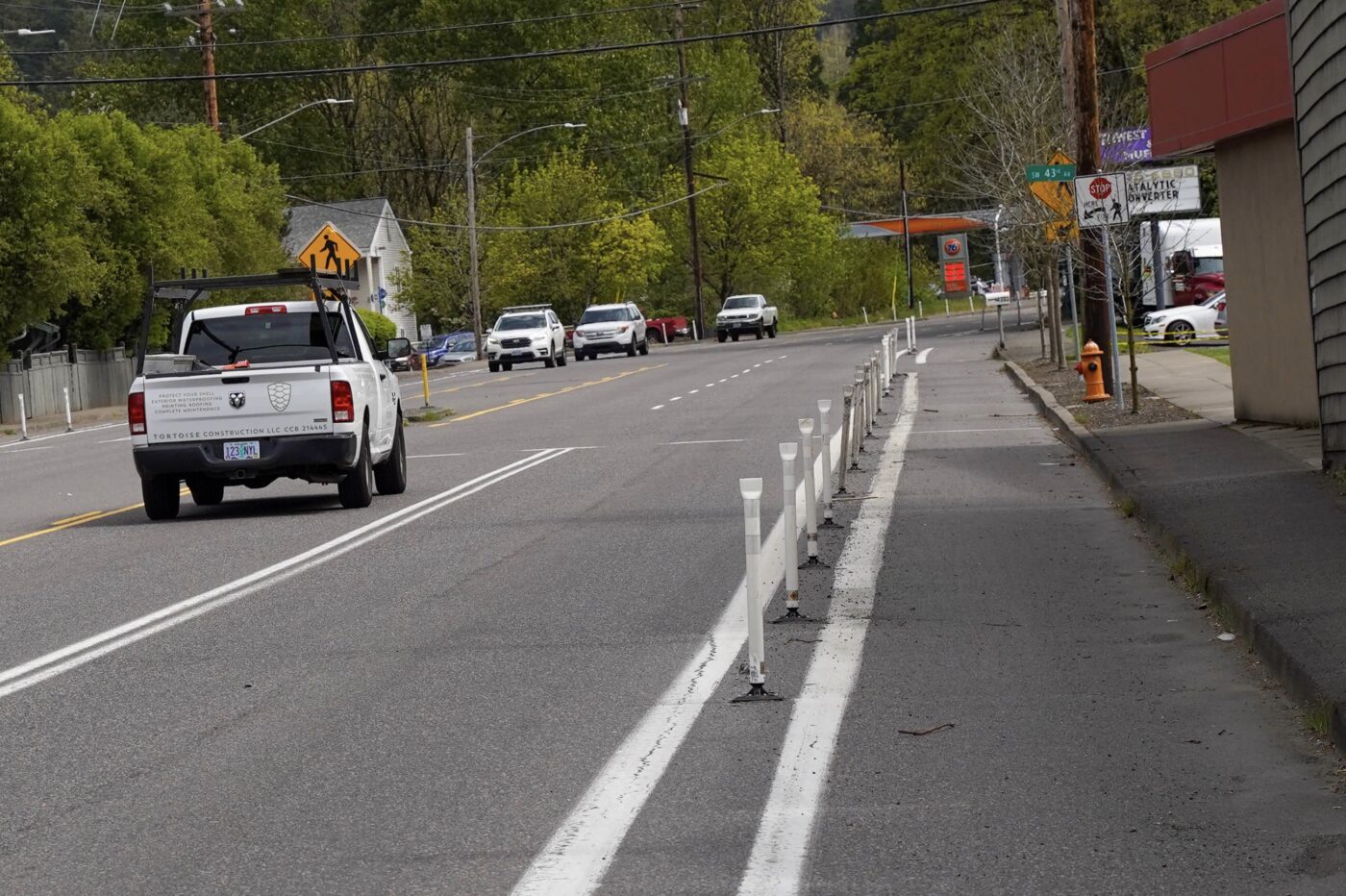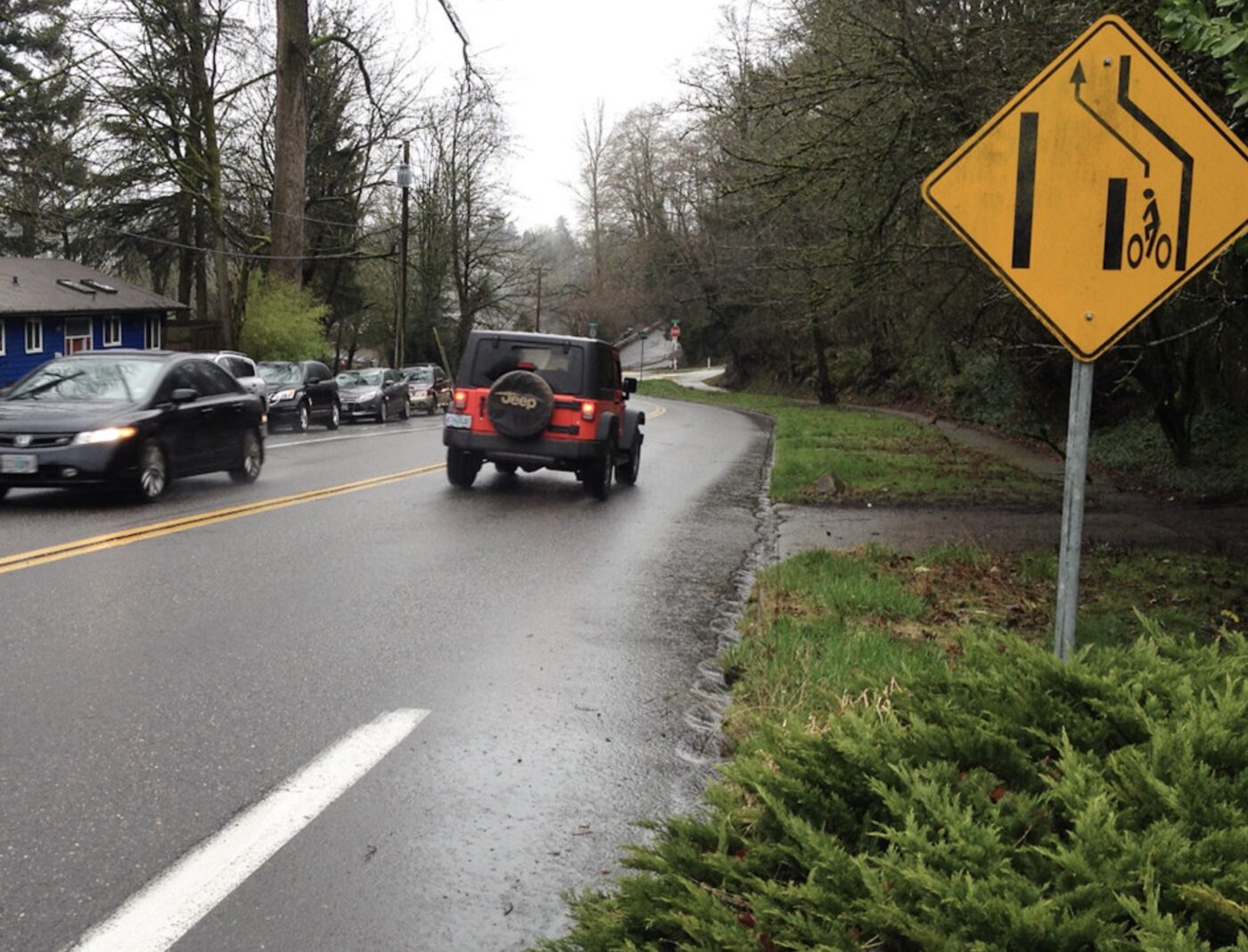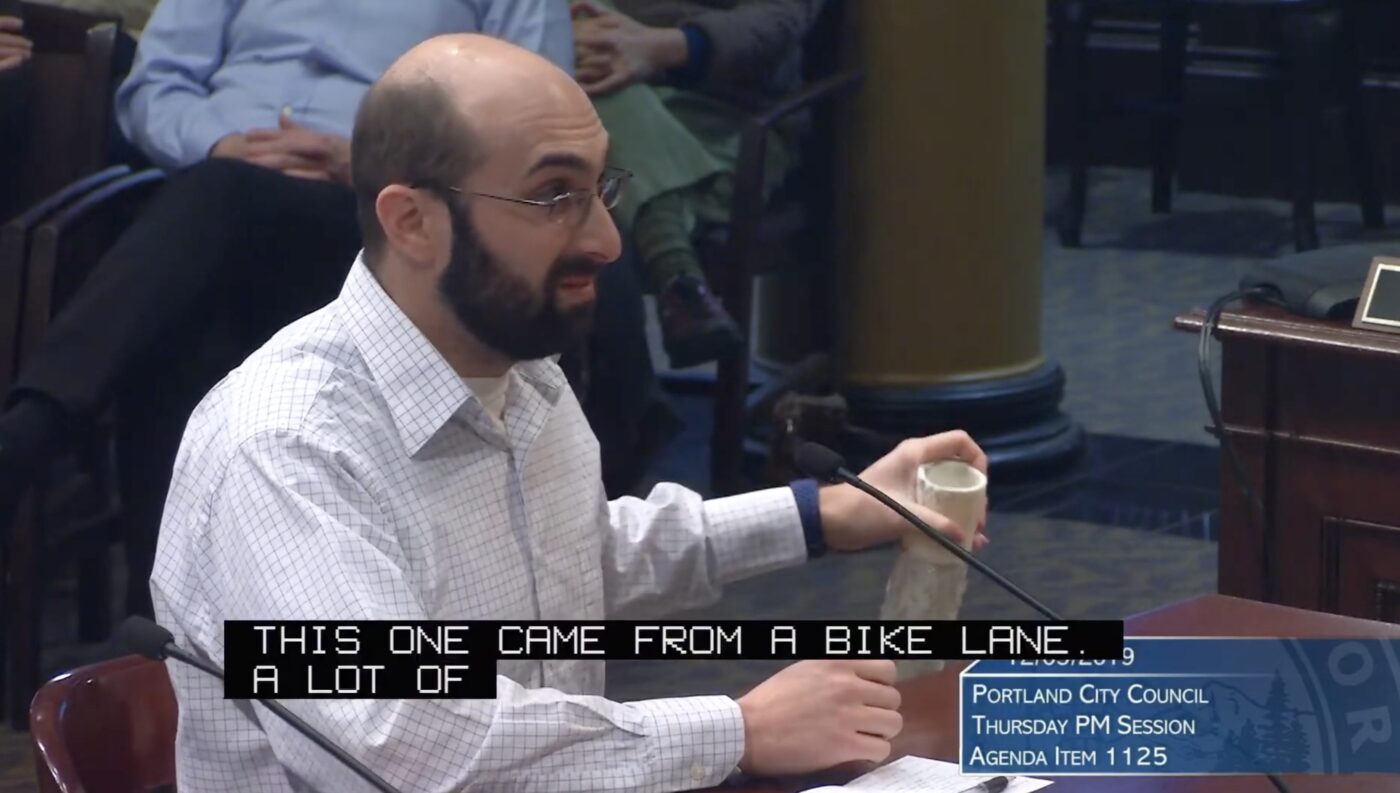
When longtime southwest Portland cycling advocate Keith Liden told me he was going to present his reasons for not wanting the plastic delineator posts on Beaverton-Hillsdale Highway “hardened”, the first thing that came to my mind was David Stein. The former chair of the Bicycle Advisory Committee (BAC), where Liden presented Tuesday evening, is a bouncing figure at the BAC Zoom meetings (he attends them on a treadmill), and he has been vocal for years about not liking the plastic posts.
As BikePortland reported last month, the Portland Bureau of Transportation (PBOT) is planning to replace some of its plastic delineator posts along bike lanes with more concrete curbs — it is going to “harden” them. And isn’t that what cyclists, including Stein, have been clamoring for?
The reason I thought of Stein was because I remember vividly the 2019 City Council session in which the Southwest in Motion (SWIM) plan was presented. Stein was one of the first persons to testify, and he brought a prop with him to the hot seat in front of the council dais — a broken plastic post he had retrieved from Beaverton-Hillsdale Hwy. Waving it before the Commissioners, he testified, “We need to do better than this!”
Five years later, enter Liden, with his usual thoughtful, well-researched and persuasive arguments. Here’s what he told the BAC on Tuesday night.
Liden’s case against Beaverton-Hillsdale Hwy hardening
The main thrust of Liden’s criticism is that the hardening project is premature. Calling B-H Hwy “the strongest link in the chain” of a poor network, Liden told the BAC Tuesday night, “most of the streets that you connect to are hostile bike environments.” “It’s not even that they don’t have facilities, it’s that they are actually hostile.”
The problem is that connectivity is so poor in southwest Portland that a cyclist doesn’t have a safe route to reach B-H Hwy. I think it helps to think of B-H Hwy as a river, and to view the few streets which cross it as very infrequent bridges. Those crossings are used by all modes—cars, pedestrians, cyclists—and except for Terwilliger Blvd, they don’t have sidewalks or bike lanes.

Shattuck Rd, where the proposed development of the Alpenrose Dairy is located, is a good example of this. Shattuck Rd lies at the center of PBOT’s proposed B-H Hwy post hardening project (between 39th and 65th Avenuess). Shattuck doesn’t have sidewalks or bike lanes either to the south of B-H Hwy, or to the north. Yet adding walking and biking facilities to Shattuck has been part of the Transportation System (TSP) and Southwest in Motion (SWIM) plans for years. The most recent controversy involves the Alpenrose neighbors who, to no avail, have been asking the city to extend the multi-use path on the proposed Alpenrose development’s frontage all the way to B-H Hwy.
This lack of coordination between the Alpenrose development and the B-H Hwy hardening project is another example of the city’s bureaus not rowing together. And these close-but-no-cigar gaps that arise from repeated missed opportunities are frustrating for residents to watch.
Liden went on to make the case that any money the city had for improving bike facilities would be better spent on Terwilliger Blvd, mainly because the ridership is so much higher—between 360 and 515 trips at various locations on Terwilliger, versus 70 trips per day at B-H Hwy/Shattuck. Or, as Liden summed up, “PBOT needs to think beyond making a bike facility segment really good and ask, ‘Will it do any good?'”
The project selection gripe
In addition to the Terwilliger having the greatest southwest ridership numbers outside of downtown, projects for filling the gaps in the Terwilliger route have been on the books since the 1990s. And that gets to the heart of Liden’s frustration, one shared by many southwest transportation advocates.
Advocates have spent hours and years working on project prioritization lists with the city. The SWIM project has spreadsheets of prioritized project lists, put together by an advisory committee. Hardening the posts on B-H Hwy is not on any of those lists, nor is it on the TSP. But Terwilliger is. This top-down project selection, outside of existing project lists and without community input, is an ongoing issue.
The colors of money
In response, City Bicycle Coordinator Roger Geller pointed out that PBOT has heard, “including from this committee, in written communications” that the plastic wands “don’t provide the level of comfort that we desire.” “And we are hearing very clearly messages about ‘make something permanent, use concrete rather than plastic.’ ”
Here’s more from Geller at the BAC meeting in response to Liden’s presentation:
This was also driven by the maintenance burden the posts were putting on our crews. Especially B-H Hwy, that’s probably one of our highest offenders. Those posts disappear with great rapidity, David Stein brings it up in almost every meeting…
We have a limited amount of money available to us, about half a million a year, which we are putting toward delineated bike lanes. Focusing on those that are putting the highest maintenance burden on us, or that are causing perception issues, I guess because of their aesthetics, particularly in commercial areas. Broadway and downtown is an example of that… Keith is saying , ‘Shift that money to Terwilliger,’… there are many colors of money. The work on Terwilliger, on Duniway Park is being funded as a risk-mitigation associated with a large BES sewer project… We’ve tried to get federal money for southwest Portland, and that’s money that is administered through the regional government, Metro. The southwest projects typically have not scored well with the criteria that Metro set for using those funds. Other than Capitol Hwy.
And then David Stein jumped in with some questions:
Stein: About projects in SW not scoring well with some of the regional and federal money, that’s because of equity scoring, correct? Or is that something else?
Geller: Equity is becoming more of a consideration in recent years, but, in the past a lot of the scoring was based on how well the facilities we would build would connect to regional and town centers. And so some of the southwest facilities didn’t score well relative to facilities elsewhere in the region.
Stein: Because there’s no stormwater management, so there’s no existing facilities, so if you want to build any facility and it doesn’t connect…
Geller: Well it was just the expense of building facilities in southwest relative to how well they connected into dense, commercial areas, which is how the criteria has often been set.
Then Liden interjected…
Liden: So it’s a little of a cost/benefit. How many people are you benefitting with the amount of money? And I guess that’s partly what I’m arguing with these two projects.
My takeaway
It was a revealing conversation, I left the meeting thinking that, in the southwest at least, projects are built, not according to a list of priorities, but rather in the order that funding sources are identified. That, or when a project can piggy-back on work happening with another bureau.
So implementation of southwest projects ends up being an excruciatingly slow bingo game, where the rows never seem to quite get filled. Keith Liden has been playing funding bingo for three decades, and his Terwilliger row still has a lot of empty spots.







